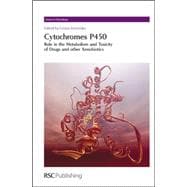
Note: Supplemental materials are not guaranteed with Rental or Used book purchases.
Purchase Benefits
What is included with this book?
| Cytochrome P450 Structure and Function: An Evolutionary Perspective | |
| Generation of Reactive Intermediates by Cytochromes P450 | |
| The CYP1A Subfamily | |
| The CYP1B Subfamily | |
| The CYP2A Subfamily | |
| The CYP2B Subfamily | |
| The CYP2C Subfamily | |
| The CYP2D Subfamily | |
| The CYP2E Subfamily | |
| The CYP2F, CYP2G and CYP2J Subfamilies | |
| The CYP3 Family | |
| The CYP4 Family | |
| Receptor-Mediated Regulation of Cytochromes P450 | |
| Modulation of Cytochromes P450 by Phytochemicals | |
| Cytochromes P450 in Cancer Therapeutics | |
| Subject Index | p. 510 |
| Table of Contents provided by Blackwell. All Rights Reserved. |
The New copy of this book will include any supplemental materials advertised. Please check the title of the book to determine if it should include any access cards, study guides, lab manuals, CDs, etc.
The Used, Rental and eBook copies of this book are not guaranteed to include any supplemental materials. Typically, only the book itself is included. This is true even if the title states it includes any access cards, study guides, lab manuals, CDs, etc.